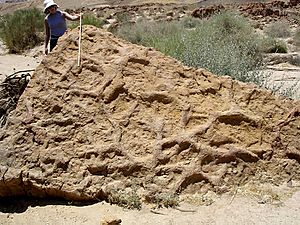Ichnotaxon facts for kids
An ichnotaxon (say "ick-no-TAX-on") is a special name given to the fossilized "work" of an ancient living thing. Think of it like a fossilized footprint, a burrow, or a trail left behind by an animal or plant. These are different from body fossils, which are the actual remains of the organism itself, like bones or shells.
The word "ichnotaxon" comes from two Greek words: ichnos, meaning "track," and taxis, meaning "ordering." So, it's about ordering or classifying tracks and traces.
Ichnotaxa are used to identify and tell apart different kinds of trace fossils. These fossils show us what ancient creatures did, even if we don't have their bodies. Scientists who study these fossils are called ichnologists. They give trace fossils names, just like how living animals and plants get scientific names. These names include a genus (group) and a species (type). For trace fossils, these are called ichnogenera (for genus) and ichnospecies (for species). You'll often see them shortened to "igen." and "isp.". Like other scientific names, the names of ichnospecies and their genera are always written in italics.
Most scientists classify trace fossils up to the ichnogenus level. This means they group together trace fossils that look similar, even if there are small differences. Sometimes, scientists try to create even more detailed classifications, but this is less common.
How Ichnotaxa Get Their Names
Naming trace fossils can be tricky! Sometimes, ichnogenera have names that sound like animal or plant body fossils. For example, many ichnogenera end with -phycus. This is because long ago, some trace fossils were mistakenly thought to be a type of ancient algae.
In 1858, a scientist named Edward Hitchcock was the first to use the common ending -ichnus for trace fossil names. He used it for a fossil called Cochlichnus.
The History of Naming Trace Fossils
Because trace fossils were hard to classify, scientists have tried to make the naming system more consistent over time. In 1961, a group called the International Commission on Zoological Nomenclature made a rule. They decided that most trace fossil names given after 1930 would no longer be officially used. This helped to clear up confusion and make the naming system clearer for everyone.
See also
 In Spanish: Icnotaxón para niños
In Spanish: Icnotaxón para niños
- Bird ichnology
- Trace fossil classification
- Glossary of scientific naming


